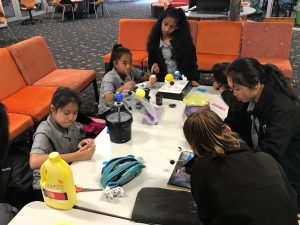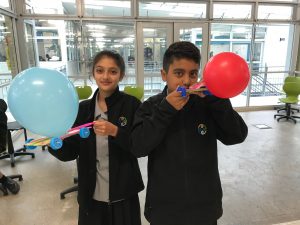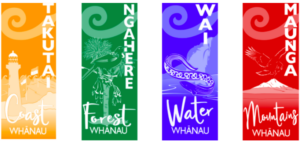Below is some pertinent information for parents and students with regards to the school’s BYOD (Bring Your Own Device) programme. This information will be updated regularly.
Recommended Devices
Our only requirements are that the device must have a keyboard for typing, have a minimum screen size of 11.6 inches and have a battery life of at least 4 hours. We are brand agnostic and do not recommend any brand over another.
It is advantageous for students to have a Mac or Windows laptop or a Chromebook which has a USB-A port due to the frequent use of software related to programming of digital microcontrollers such as the PicAxe or Microbit. We do not recommend iPads or Android tablets due to limitations inherent with their operating systems.
Windows computers should not be in S mode. S mode is a limited version of Windows that only allows the user to run applications installed from the Microsoft Store. We require users to run the Google Chrome web browser. This link shows you how to get out of S mode.
Parents are free to make their own choice regarding a specific device, supplier, insurance, after sales service and maintenance of the device. Examples of such suppliers are PB Tech, Noel Leeming or Harvey Norman.
To obtain a school discount when ordering online from PB Tech; Click on New Customer, enter your personal details, the membership key is MHJC and login with your credentials.
We also have an online portal with NXP which you can take advantage of.
Example Device Specifications
Laptop (Preferred)
- Windows operating system (not S mode), SSD hard drive, 8GB RAM, touch screen and tablet mode (detachable / convertible keyboard)
- Windows operating system (not S mode), SSD hard drive, 8GB RAM, standard laptop form factor
- MacBook Pro or MacBook Air with 8GB RAM, running macOS
Chromebook
- ChromeOS, 4GB RAM, 16GB SSD
Ideally students should have a robust and efficient device to ensure that it will stand up to the requirements of school use and so we have not considered the lowest cost machines.
None of the devices in the list above have low end specifications, and are therefore not the cheapest available. It will be advisable to discuss the specifications of any machine with your chosen provider who will assist you in your purchase decision.
Digital Citizenship
The Ministry of Education has created an excellent resource on Digital Citizenship. This resource is available at the link below;
http://elearning.tki.org.nz/Professional-learning/Digital-citizenship-modules
BYOD Frequently Asked Questions
What are the advantages of BYOD?
- Anytime, anywhere access to class resources and support through Google Apps, MHJC Online and other cloud based applications.
- The ability to create a personal digital portfolio of their own work using cloud based applications such as TinkerCAD and LucidChart
How does BYOD change education?
- Increased engagement in the learning process as students become more active participants in their learning.
- Greater ability to communicate with teachers and other students through access to student email.
- The ability to draft, redraft and publish work.
- Greater independence, collaboration with peers and personalised learning.
- Improved critical thinking and development of multi-literacies.
- Greater integration of technology and the use of digital learning tools that complement existing teaching programmes.
- Improved innovation as the use of devices in the classroom evolves.
What device should I buy for my child? Why did you not mandate one device that all students would have?
We are brand agnostic and we recommend that all things being equal, parents purchase the most affordable device available. Our recommendations are listed in the Recommended Devices List below.
In addition, some of our students already have devices which they and their parents may wish to use. There is not one single device that is best for all students at all levels covering all subjects and activities – whatever we may have chosen would not be best suited for all students.
Exceptions are only granted in the following circumstances :-
a. ORS funded students
b. Student with existing assistive technologies mandated by the Ministry of Education.
Why can’t students use a phone?
Phones are well suited for communication tasks such as Whatsapp, voice calling and texting but ill-suited to heavy text, mind-mapping and spreadsheet data entry.
Why have you chosen all year levels for BYOD? Why can’t only Year 9s and 10s be enrolled into that program?
We have discovered that many of our students have BYOD programs in their previous schools. This is a natural continuation for them and they can continue using their device as they progress through the year levels in MHJC.
I’m concerned about cost. Shouldn’t devices be provided by the school?
While the school could maintain a 2:1 ratio, it does not have the resources for a 1:1 student to computer ratio.
Buying a device for your child is a major decision and a significant outlay. A good quality device should last Years 7 to 10 at school and so this cost is spread over 4 years.
All students need their own device rather than the use of a shared device. This is because MHJC is integrating device use into many aspects of teaching and learning and your investment in a device will enhance learning outcomes for all students.
Wouldn’t it be easier for teachers/students if there was only one device? Won’t it be too hard/impossible for teachers to make use of such a variety of different machines? If they had one machine, they would be able to teach the students how to use it more efficiently.
It would certainly be easier for most teachers. However, one device will not be able to accommodate all learning areas. It also might be too restrictive or demanding for some students and families.
We are also of the view that the specific device is not the issue at hand; it is the task of educating that is more important. If we are writing an essay or analysing a pattern trend, the focus is on the content and not the word processor or spreadsheet program.
Can students charge their device in school?
Currently, we have limited facilities for the charging of personal devices in the school. Students are required to charge their devices fully the night before. Parents are also advised to procure suitable rechargeable power packs for their child’s devices.
Will the school repair the device if it breaks? Does the school provide loan machines for students whose devices are broken?
The school does not have any authorised personnel who can repair devices. It is advantageous to purchase the device from a provider who can offer advice, service, loan out machines, repair and lease options to go along with the purchase of the device.
May the students use 3G/4G in addition to WiFi?
The Student Cybersafety User Agreement requires students only to use the school provided wifi. This is a safe and monitored network. Students are not allowed to use their 3G/4G data plan while on campus.
When using their personal device, can the student’s internet activity be followed by the teacher?
Yes, when the student is on our BYOD network. If a teacher witnesses a student on a website outside the auspices of the AUP, the procedures in the AUP guideline will be followed.
Which is better, a laptop or a tablet?
Laptops are generally larger, less portable, have lower battery life, built-in keyboard, but have a full operating system and more specialised functionality for advanced activities.
Tablets are generally more portable, have a longer battery life and are very good for communication and simple tasks. They are considered to be a ‘personal consumer device’ for consuming the product of other people’s work, such as information on the internet. They are not best suited to ones’ own work productivity, especially tasks requiring multiple screens, high processing power, memory or full applications. As such, we do not recommend tablets at all.
Touch screen laptops with tablet mode provide the best of both worlds regarding functionality, but are the most expensive option.
Do I need to purchase Microsoft Office software for my child?
No. We use Google Apps and LibreOffice exclusively in MHJC.
How many devices can my child use at school?
MHJC students can only register ONE device to the school’s WiFi network.





